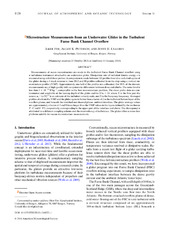Microstructure Measurements from an Underwater Glider in the Turbulent Faroe Bank Channel Overflow
Peer reviewed, Journal article
Published version
Permanent lenke
https://hdl.handle.net/1956/8995Utgivelsesdato
2014-05Metadata
Vis full innførselSamlinger
- Geophysical Institute [1198]
Originalversjon
https://doi.org/10.1175/jtech-d-13-00221.1Sammendrag
Measurements of ocean microstructure are made in the turbulent Faroe Bank Channel overflow using a turbulence instrument attached to an underwater glider. Dissipation rate of turbulent kinetic energy « is measured using airfoil shear probes.Acomparison is made between 152 profiles from dive and climb cycles of the glider during a 1-week mission in June 2012 and 90 profiles collected from the ship using a vertical microstructure profiler (VMP). Approximately one-half of the profiles are collocated. For 96% of the dataset, measurements are of high quality with no systematic differences between dives and climbs. The noise level is less than 5 x 10-¹¹ W kg-¹, comparable to the best microstructure profilers. The shear probe data are contaminated and unreliable at the turning depth of the glider and for U/ut < 20, where U is the flow past the sensor, ut =(ε/N)¹/² is an estimate of the turbulent velocity scale, and N is the buoyancy frequency. Averaged profiles of ε from the VMP and the glider agree to better than a factor of 2 in the turbulent bottom layer of the overflow plume, and beneath the stratified and sheared plume–ambient interface. The glider average values are approximately a factor of 3 and 9 times larger than the VMP values in the layers defined by the isotherms 3°–6° and 6°–9°C, respectively, corresponding to the upper part of the interface and above. The discrepancy is attributed to a different sampling scheme and the intermittency of turbulence. The glider offers a noise-free platform suitable for ocean microstructure measurements.
